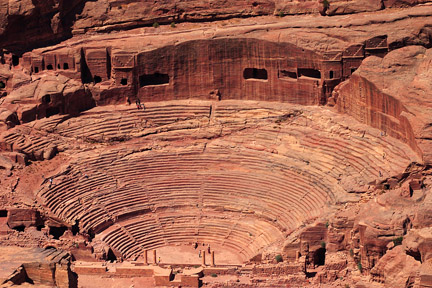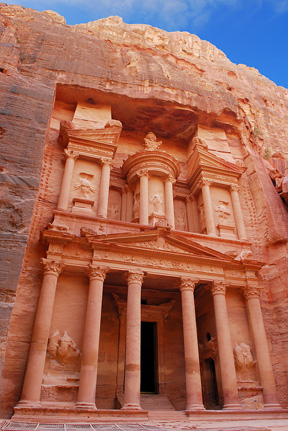Petra
History and Construction
South America is a continent situated in the Western Hemisphere, mostly in the Southern Hemisphere, with a relatively small portion in the Northern Hemisphere. The continent is also considered a subcontinent of the Americas. It is bordered on the west by the Pacific Ocean and on the north and east by the Atlantic Ocean; North America and the Caribbean Sea lie to the northwest.
South America ranks fourth in area after Asia, Africa, and North America and fifth in population after Asia, Africa, Europe, and North America.

Petra in Jordan is one of the new Seven Wonders of the World and its most famous tourist attraction. This Archaeological Park covers a 264 dunum (264,00 square meter) area within Wadi Musa, which is considered a tourism and archaeological site. The area encompasses a breathtaking landscape of pink-hued rock mountains, the focus of which is this amazing ancient Nabataean city.
|
It was first established sometime around the 6th century BC, by the Nabataean Arabs, a nomadic tribe who settled in the area and laid the foundations of a commercial empire, turning it into an important link for the silk, spice and other trade routes that linked China, India and southern Arabia with Egypt, Syria, Greece and Rome. The city of ancient Nabataea and was famous above all for its trade and its hydraulic engineering systems. |
It lies on the slope of Mount Hor in a basin among the mountains which form the eastern flank of Arabah (Wadi Araba), the large valley running from the Dead Sea to the Gulf of Aqaba. This ancient Nabataean city has much to offer its visitors and is a must-see for anyone interested in history, archaehlogy, nature or culture.
The site remained unknown to the Western world until 1812, when it was introduced by Swiss explorer Johann Ludwig Burckhardt. In 1812, he set out to ‘rediscover’ Petra; he dressed up as an Arab and convinced his Bedouin guide to take him to the lost city. Burckhardt's accounts of his travels inspired other Western explorers and historians to discover the ancient city further. After this, it became increasingly known in the West as a fascinating and beautiful ancient city, and it began attracting visitors and continues to do so today. This ancient city is also known as the rose-red city, a name it gets from the wonderful color of the rocks from the red-hued sandstone mountains from which many of the city’s structures were carved.
This ancient city was built by the Nabataeans more than two thousand years ago and it flourished in the first centuries BC and AD. Today some of the elaborate facades that are sculpted into the sandstone cliffs of the mountainous area can still be seen, along with other incredibly preserved structures and monuments of this fascinating ancient civilization.
The entrance to Petra is through a long, winding sandstone canyon known as the Siq. Before reaching the Siq, visitors walk through an area called ‘Bab Al Siq’. There are several monuments of note along the way starting with three massive Djinn or god blocks, the Obelisk Tomb and the Triclinium below it.
The Siq is a narrow gorge, more than a kilometer long, which leads visitors into this ancient site, opening up at the Treasury. As well as presenting a dramatic entryway into this ancient city, many relics can be seen in the Siq including a paved road and Nabataean sacred stones. The most impressive sights are the colorful and unusual sandstone patterns in the rock walls.
Upon exiting the Siq, visitors can view the most magnificent of Petra's sights. One of the most elegant remains of the ancient world, the Treasury is carved out of solid rock and stands over 40 meters high. The structure got its popular name from the Bedouin belief that pirates hid ancient pharoanic treasures in the giant stone urn which stands in the center of the second level. Although the original function is still a mystery.
Past the next turn is the outer Siq or Street of Facades, a large canyon lined with the facades of various monumental Nabataean tombs carved in the southern cliff face of the outer Siq. The facades are crowned with corner crow-steps, pilasters, and cavettos.
At the end of the Street of Facades is the Roman Theater that was created by the Nabateans. This was carved into the side of the mountain at the foot of the High Place of Sacrifice. It consists of three rows of seats separated by passageways and seven stairways ascend the auditorium and can accommodate 4000 spectators. The back wall of the stage was rebuilt by the Romans.On the side of the valley opposite the Roman Theater and a short walk up the hill, are the Royal Tombs. They are quite grand in scale compared to the others in the area.
The Monastery is one of the largest monuments in Petra. The Monastery is superbly carved and it is similar to design to the Treasury, but it is much larger and much less decorated. It is so colossal that the doorway is many stories tall. The facade is flat on the lower level and deeply carved on the upper level, with engaged columns and two half-pediments flanking a central urn (10 meters in hight).
The Great Temple Complex represents one of the major archaeological and architectural components of central Petra and is estimated to cover an area of 7000 square meters. One of the largest Nabatean complexes in Petra, the Great Temple is a two-level structure.
The Church, this basilica contains three inscribed apses with three corresponding entrances in the western wall and well preserved floor mosaics pave both side aisles and attest to the church’s significance. The church dates to the end of the 5th century AD. The building materials used in constructing the church, including the capitals, door jambs, and reliefs were from the ruined monuments of the Nabataean and Roman periods.
In addition to these magnificent monuments in this ancient Nabataean city, there are many more other spectacular sites that visitors should not miss.


